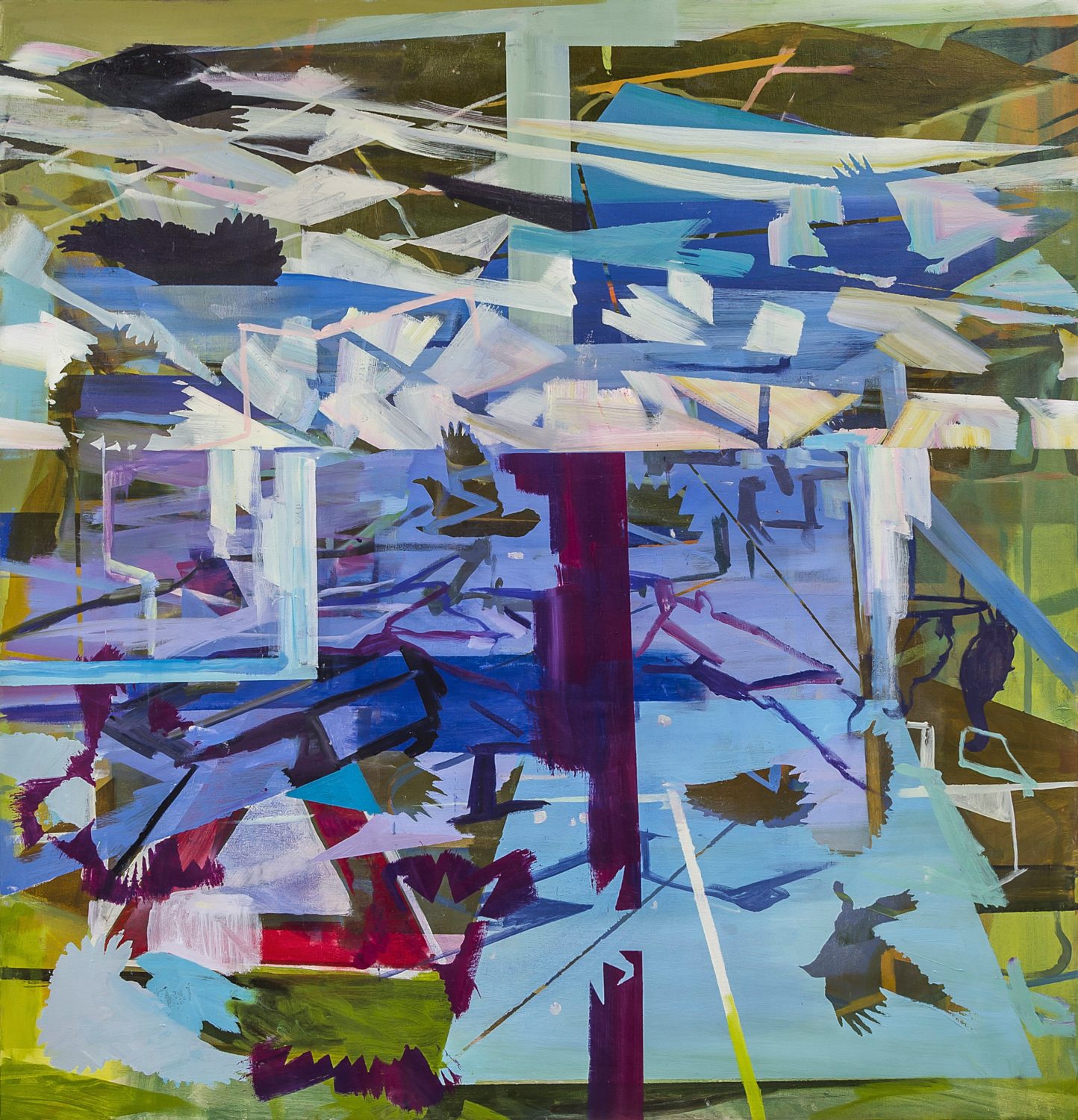“Break Down, Build Up” at the Great Park Gallery extols the majesty, subtlety and even dystopian aspects of contemporary landscapes; while the show’s title refers to different approaches to painting by two participating artists. Marie Thibeault is the break down — or abstract — artist in this show, while Daniel Dove’s work is more representational or built up, according to curator and gallery assistant Adam Sabolick.
Yet the painterly aspects of the large-scale work by both artists are among this exhibition’s most compelling features. Indeed, Thibeault and Dove approach the application of paint to canvases with so much passion and love that their work imparts scintillating energy.
Thibeault, who lives in San Pedro near the Port of Los Angeles, often drives through the area, observing cranes, bridges, ships, shipping containers and birds overhead. Employing semi-abstract expressionist techniques, she combines and layers details of these observed images, along with organic biomorphic shapes, which are conjured up from her imagination.

“High Tide” – By Marie Thibeault. (Photo courtesy of the artist)
The artist approaches her work intuitively, initially drawing, collaging and stenciling her images onto paper. She then applies bright primary and muted colors to her oil paintings, creating abstract work that seems to explode with color, form and fluidity. Her “High Tide” is an amalgam of symbols seen in her nearby industrial environment, painted against an overlay of pale to deep blues, with hints of green, along with several images of birds. This poetic visual rendering depicts life among nature; yet one that is simultaneously tempered by the benefits and spoils of an industrial society.
The artist’s “Gravity’s Angel” combines bright pinks with oranges and yellows, overlaid onto darker gestural brushwork to illustrate what she refers to as, “the tension between instability and balance, breakdown and recovery, with the use of architectural structures within organic conditions.” Her paintings “Shield” and “Moving Cities” are darker, containing deep blues, greens and black, while their imagery is both obscure and densely painted. These pieces are in part the artist’s response to events in our lives that are beyond our understanding and imagination, and that also include ruination.
Thibeault’s MO, both intuitive and explicit, combines industrial shapes with organic forms, while including bright and deep colors. The resulting artworks are the passionate visual equivalent of Tchaikovsky’s seminal composition, “Violin Concerto in D Major.”

Photo by Gene Ogami
Dove, the more representational artist in this exhibition, employs “modernist artworks and designs of the 20th century.” With this in mind, several of his paintings contain images of classic yet discarded Eames chairs and other mid-century furniture designs. He refers to these furnishings as “ruins” and to out of control consumption. Some of his other pieces appropriate the designs of American artist Frank Stella, who often used geometric patterns in his work, and of French painter and sculptor Jean Dubuffet.
While Dove’s paintings are more representational than Thibeault’s, they also contain abstract elements of chairs suspended in the air and reflections from buildings. And like Thibeault, Dove is obsessed with the medium of paint (as the French Impressionists often were), noting that applying paint to canvas asserts the presence of a human being. This process also helps to convey the painter’s artistic energy and intentions to the viewer.
Dove’s painting “Cranbrook,” named after the Detroit-based Cranbrook Academy of Art (which houses furnishings as art pieces) is one of his more sedate paintings, with several Eames chairs neatly stacked in two rows, perhaps in a shipping container. This artwork’s design, with its curved furnishings, echoed by similar drawn geometric shapes, is semi-abstract. The artist’s painting, “Stella,” is more abstract and even chaotic, with several Eames chairs and other furniture pieces jumbled against a background that features a Frank Stella mural.

Photo courtesy of the city of Irvine.
Moving further into abstraction, Dove’s painting titled “Puzzler” appropriates the forms of a Dubuffet sculpture. Yet here the various shapes appear disembodied, resulting in a slightly surreal appearance. His “Trixter,” in shades of grays, browns and whites, contains similar shapes. But these figures are even more abstract and surreal, perhaps echoing those of French surrealist Yves Tanguy.
Contrasting with Dove’s furniture and sculpture work are his paintings “Cigarette,” in greens and yellows, and his “Double Echo” in various shades of red. In these two works, he paints a bucolic scene as it is reflected in the surface of a large industrial building, albeit one that is in disrepair.
Perhaps these paintings, which depart from depicting the actual structures, are the artist’s reaction to a world in chaos. Or as Peter Frank writes: “The expansive apocalypses painted by Daniel Dove and Marie Thibeault reflect both the looming entropy of earthly biology and the sense we have of disappearing down that entropic chasm.
The two painters posit this global drama in terms not of natural extinction, however, but of cultural collapse: our humanity will disappear and only its larger, more imposing artifacts will remain behind as mute and sorrowful gravesites.”
Frank, an L.A.-based art critic, curator and poet, will lead a discussion with Thibeault and Dove at the Great Park Gallery on Sunday, January 26 from 1 p.m. to 3 p.m. Frank also comments about the two artists’ work: “Indeed, the ironic beauty of their painting only heightens our sense of tragic and impending loss.”
“Break Down, Build Up” is on view through February 9, 2020. Great Park Gallery, Palm Court Art Complex, Orange County Great Park, Irvine; Thu. & Fri., noon-4 p.m., Sat. & Sun., 10 a.m.-4 p.m.; free. cityofirvine.org/orange-county-great-park/arts-exhibitions.
Advertising disclosure: We may receive compensation for some of the links in our stories. Thank you for supporting Irvine Weekly and our advertisers.

